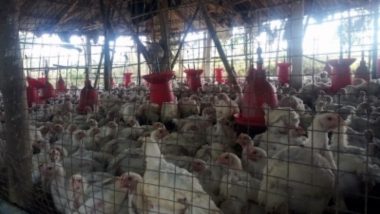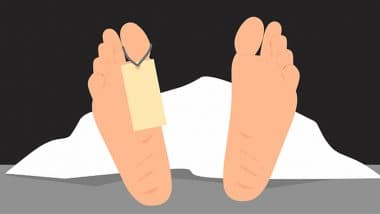New Delhi, April 1: In times of fake news and WhatsApp forwards, it is difficult to ascertain verified and truthful information. Social media platforms such as Facebook and Twitter are flooded with fake news and misinformation around the coronavirus outbreak, causing panic and fear. The Press Information Bureau (PIB) has spoken to senior scientist in Vigyan Prasar Dr TV Venkateswaran who has answered some of the most commonly asked questions around coronavirus. 'Stop Eating Bakery Items' Viral Photo Claiming WHO Asking People To Avoid Eating Bakery Products Amid Coronavirus Pandemic is FAKE! Here's The Fact Check.
Questions such as 'who can infect?', 'where did the virus come from?', 'can coronavirus infect animals?' and 'who are the most vulnerable?' have been answered by Dr TV Venkateswaran. Here are all FAQs answered by the senior scientist. Coronavirus Outbreak Live News Updates on April 1.
Who can infect?
Anyone infected with the virus can infect even before the symptoms appear. Most carriers do not even show signs. Covering our mouth and nose when we cough or sneeze will help reduce the infection. The virus is present in the saliva, sputum and faeces of the infected person for the whole infectious period.
How we infect:
Transmission is mostly via droplets. This requires relatively close contact, less than 6 feet. This is why it is recommended that we stay 1.5 metres away from each other in public places such as the vegetable market or supermarket. A study done in Hong Kong shows that social distancing can reduce the spread by 44%. Inanimate vector of disease, in particular phones, doorknobs, surfaces are a potential source for transmission, but not much is known about it. It is safe sanitise out hands after touching doorknobs, lift call buttons and counters in public places.
How many we infect:
The average number of new infections caused by a typical infectious person, that is human transmissibility range (R0) is between 2.2 to 3.1. In simple word, one infected individual on the average infects about 2.2 to 3.1 persons. By physical distancing, we can artificially reduce the actual transmissibility, thus slow the rate of infection.
Where did the virus come from?
It is not from eating bat soup. Once you boil, the virus is decimated. Initially, it was speculated that the SARS-CoV-2 virus jumped from bat to humans. But recent genomes study show first it must have leapt from bat to an intermediary species before it latched on to humans. Another study indicates that a lineage of SARS-CoV-2 virus was circulating in humans before the disease outbreak.
How it evolved:
SARS-CoV-2 has emerged either by natural selection of virulent strain in a non-human animal host before zoonotic transfer to humans or natural selection of virulent strain in humans following a zoonotic transmission. Only more studies will show which of the two is right. We still are not clear what are the mutations in SARS-CoV-2 that allowed human infection and transmission.
When did SARS-CoV2 emerge?
While here have been no documented cases of SARS-CoV2 before December 2019. However, preliminary genomic analyses suggest that the first human cases of SARS-CoV-2 appeared between mid-October and mid-December 2019. This means there was a period of unrecognised transmission in humans between the primary zoonotic event and the outbreak.
Can it infect animals?
The molecular modelling suggests that SARS-CoV-2 can affect besides human, bat, civet, monkey and swine cells. Does not infect domestic animals or livestock. Consuming eggs or poultry will not result in SARS-CoV-2 infection.
Can one be infected twice:
Once we get measles, most of us acquire life long immunity. We hardly get measles again. Experimentally infected macaques were not capable of being reinfected. Likewise, there is no evidence of reinfection with SARS-CoV-2 after recovery in humans. However, how long the immunity will last is unknown.
How severe is the illness?
COVID-19 is not a death sentence. The majority of COVID-19 cases are mild (81%), About 15% need hospitalisation and 5% require critical care. That is the vast majority of the infected will not even need hospitalisation.
Who are the most vulnerable?
Healthcare workers are most susceptible. About 20% of healthcare workers in Lombardy, Italy becoming infected while providing medical care to patients.
Among the general public, aged, in particular above 60 years of age and people with prior cardiovascular disease, hypertension, diabetes, and respiratory conditions have a higher risk.
What is the cause of the death?
Most of the deaths is caused by respiratory failure or respiratory failure combined with heart damage. Leakage of fluid into the lungs, which inhibits respiration and leads to morbidity, is the primary clinical condition. At present, the treatment for COVID-19 is primarily supportive care, including ventilation if necessary. Several therapeutic trials are ongoing, and the results are awaited.
Are the virus transmitted by milk sachets, or newspapers?
SARS-CoV-2 can persist on plastic and stainless steel surfaces for up to 3 days. When the viral load was 10000 PFU, it lasted on newspaper and cotton cloth only for 5 minutes. Washing the milk sachets is adequate to remove the virus.
Will it spread through the air?
In the air, the virus can survive only up to 2.7 hours. Therefore being in open spaces such as a balcony, the terrace is no harm.
Is there a less virulent strain?
While many strains are being identified, studies so far have not indicated any mutations that are linked to any changes in transmission or disease severity.
Will, the onset of summer or rainy season, gives respite?
No strong evidence exists showing a reduction in transmission with the seasonal increase in temperature and humidity.
The total number of coronavirus cases in India has climbed to 1,637, causing 38 deaths, according to the data furnished by the Union Ministry of Health and Family Welfare. A total of 132 patients have been cured and discharged so far.
(The above story first appeared on LatestLY on Apr 01, 2020 08:06 PM IST. For more news and updates on politics, world, sports, entertainment and lifestyle, log on to our website latestly.com).














 Quickly
Quickly



















